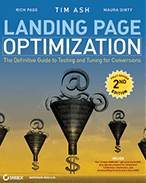10 Ways to Improve Site Navigation that Your Visitors Will Love
Last updated | Welcome to the first in my new series of ‘Win at Website Optimization’ – these posts are designed to help you learn and understand major areas of websites that can be improved to increase conversion rates and visitor satisfaction rates (so they spend/engage more often, and come back more often).
Welcome to the first in my new series of ‘Win at Website Optimization’ – these posts are designed to help you learn and understand major areas of websites that can be improved to increase conversion rates and visitor satisfaction rates (so they spend/engage more often, and come back more often).
This first in the series focuses on improving website navigation – without good navigation, your visitors will simply leave your site, go back to Google and click to your competitors who have better navigation. So, I present to you my top 10 ways you can improve your navigation to help satisfy your visitors needs and make sure they come back for more…
1: Review the wording of your navigation menus. Is it obvious what the user will get after clicking on one of your navigation tabs? Many sites use wording in menus that is very vague or unclear what its likely to be about. Particularly guilty are trendy websites that deliberately break the mold to try and be cool, but often just end up confusing the user instead. Dumb down navigation tab text – never have jargon in them that might confuse a visitor, and never presume your visitor will know what you mean (best to put yourself in their shoes).
2: Remove some less important elements from navigation. You don’t have to offer every major section in your navigation. Research has actually shown that if you offer a user too many choices, it actually hinders their ability to chose anything (‘less is more’ philosophy). Usually the major categories will suffice in your navigation menu, and making use of drop down menus will enable to the visitor to see what else is available (see next point). An example of a bad offender of this is the Frys.com website navigation (see below) – way too many tabs. Time they had a major navigation redesign I think!
3: Add drop down menus to your navigation menus. This helps users explore your site without actually clicking on anything. A great example of this is the top navigation at AmericanEagleOutfitters.com. Its particularly useful when you have many different sections and sub sections on your website that you need to highlight. Vertical drop down menus are slightly better than pop-out sideways menus – those style are prone to the user accidently slipping off thin navigation tabs into another tab, which is frustrating after trying to navigate to sub menus (I think Amazon.com needs to fix this issue in the left hand nav). And most drop down menus have become SEO friendly, and aren’t as slow as they used to be at loading – so now there are less reasons to not use drop down menus!
4: Improve your browse/sorting capabilities– this is particulary important for ecommerce stores. Always include the ability to drill down into different browse sub-categories, and always offer the ability to sort items by price, top sellers, release date, and very importantly, by top customer review ratings – users often want to browse by the most popular products. Crutchfield.com does a great job of searching/browsing by highest rated products.
5: Don’t forget about internal site search. If your site visitor can’t find what they are looking for by browsing or using your navigation menus, then they will usually try one last thing before giving up and leaving to one of your competitors. And that is by trying to search your site for what they are looking for. Not only is it important to have an internal site search box in the top right of every page to cater for this need, but its also important to make sure you have relevant search results, and the ability to run advanced searches.
6: Make use of related links, with enticing call to actions. Always give your visitors related options after they are done reading something. Too many times I read something on a website and find myself thinking ‘hmmm, now what’. Clear related links should be presented towards the end of the page to have most effect, with enticing calls to action to make someone want to explore more on your site (like ‘see other great restaurants in your area’). Using related links helps keep traffic flowing around your website – ultimately you want them to stay on your site for as long as possible!
7: Use personalization/behavioural targetting wherever possible. Imagine going to a website that knows exactly what content to show you based on what you have seen most often before. And I’m not just talking about showing product recommendations ala Amazon.com. I’m talking about showing substantially different content on pages. This is likely to engage the user to a far higher degree and keep them coming back for more. While this is a more advanced optimization technique, at the very least try and offer some personalization features so visitors can customize their own site experience.
8: Always include a well designed site map.Some users actually prefer to look at a site map than actually trying to use navigtion, browse or internal searches. Its often a good way to outline exactly what your website has to offer. And its very important for customer support sites to have a site map that clearly shows the different support options available.
9: Your website visitors need help! One of the best ways to increase the likelyhood of someone purchasing from you again, or visiting you again, is to be able to anticipate and resolve any issues the user may have when using your site or ordering/returning products, and placing this information in a easily found help section. Its now becoming a standard to include a prominent ‘help’ link in the top right – and users often look in that area first to obtain support. If help is not easily found, warning bells can often sound for the visitor.
10: Include navigation breadcrumbs on your site. Not necessarily to be used as a major navigation method, but its an important safety net for visitors to click on if they don’t know where abouts they are on your website. Particularly if they have arrived from a search engine deep within your website. These are best found in the top left, just under the main navigation menus, and each element of the breadcrumb trail should always be clickable.
So there we have it – 10 great ways to help improve your website navigation that your website visitors will be sure to love! Hopefully you found this very useful – look out for my next in this ‘Win at Website Optimization’ series soon!



